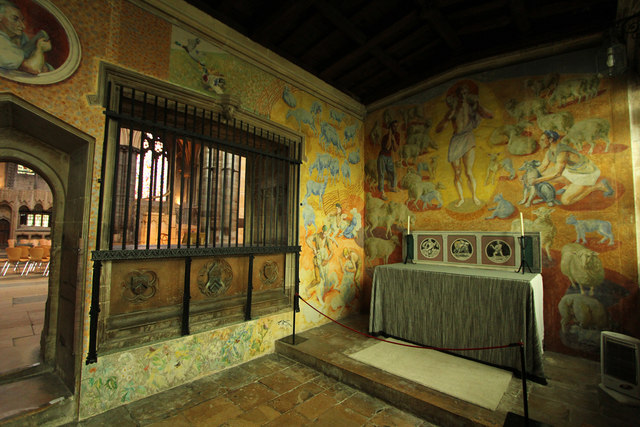SK9771 : Russell Chantry
taken 10 years ago, near to Lincoln, Lincolnshire, England

See other images of Lincoln Cathedral Interior
Duncan Grant (1885-1978) from Scottish aristocratic roots, was an influential artist of the early 20th century, conscientious objector in the First World War and member of the Bloomsbury Group, whose attitudes towards feminism, pacifism and sexuality brought them great notoriety. Though homosexual, he had a daughter, Angelica, by his 40-year largely platonic relationship with Vanessa Bell (sister of Virginia Woolf), and several notable lovers including Bloomsbury set fellows, the economist John Maynard Keynes and writer David Garnett. His later life was spent with another Bloomsbury associate, poet and translator of the classics, Paul Roche.
The mural paintings in The Russell Chantry, St.Blaise Chapel in St.Maryís Cathedral are dedicated to St.Blaise, patron Saint of wool workers and depict a fanciful quayside scene in 15th century Lincoln. They were painted in 1958, when Grant was in his early seventies and were embroiled in controversy from the start. His initial designs were amended and his open homosexuality and history as a conscientious objector were frowned upon in the early post-war years. The Chapel was kept locked from around 1964 to 1977 when the first colour Cathedral guidebook made no mention of the murals and it continued to be locked and used as a storeroom with cupboards against the walls covering the murals until 1990. Some people objected to the near nudity of the figure of Christ, modelled on Grantís homosexual lover Paul Roche and athletic young porters loading bales of wool on the quayside. Even today, some Cathedral guides omit the St.Blaise Chapel and Grantís marvellous murals from their tour.
Cathedral Church of St Mary, Lincoln. Grade I listed.
After the Norman Conquest, William wanted to establish a northern stronghold, and chose the old Roman city of Lincoln.
The Benedictine monk Remigius, Bishop of Dorchester was asked to transfer his Cathedral to Lincoln. He decided to set it up as a Minster, with no monks. The Cathedral was finished in 1092 and the original three arches can been seen on the west end to this day.
Around 1141 the Cathedral was damaged by fire and rebuilding was ordered by Alexander the Magnificent. This probably included stone vaulted ceilings and some of the western exterior arcading.
In 1185 an earthquake caused great damage. The next year a bishop named Hugh of Avalon arrived, and commenced rebuilding in 1192 in the Gothic style of architecture. However, the tower collapsed in around 1237, and rebuilding had to start again, including the great transept, the Deans Eye Window in 1235 and the Nave which is Early English. The Font is 12th C, carved in Tournai, France (now Belgium), showing mythical beasts.
Hugh died in 1200 and many miracles were experienced by pilgrims to his tomb, he soon became St Hugh. By 1255 many pilgrims were visiting his tomb, so the east end was extended again to accommodate the growing cult. St Hugh's body was transferred to the new Angel Choir in 1280.
The Bishop's eye window in the south Transept was re-built in 1330. It resembles two leaves. The chapter house is 10-sided and dates from 13th C.
Around 1310 the tower was raised and the two western towers heightened, with the proceeds of the visiting pilgrims. Wooden lead-covered spires were added, making the Cathedral the tallest building in the world for 200 years until the central spire collapsed in 1548.
Bishop Grosseteste and Bishop Alnwick followed, and in the 16th Century the chantry chapels were dissolved. St Hugh's shrine was stripped and income dropped as a result. In the civil war the Cathedral was pillaged, and services were abandoned, with the Cathedral soon falling into disrepair.
Revival in the late 17th C with Dean Michael Honywood followed, although funds were still short.
By the early 18th C. the western towers were leaning badly. James Gibbs, Architect added cross walls and a narthex at the west entrance. The towers are still not straight even today. In 1807 the spires were removed for safety. Repairs to the Deans Eye window were required in the early 21st C. as it was found to be in very poor condition.
Lincoln is the third largest Cathedral in the UK and contains many interesting tombs and memorials, and of course, the Lincoln Imp.